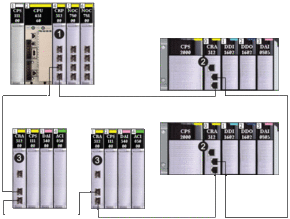Introduction
Your application can include:
communications with a simple remote I/O daisy chain loop
communications with a mix of remote I/O and distributed I/O networks
The cable connections to the 140CRP31200 remote I/O head module on the local rack are different in these scenarios. They are discussed below.
Each device network port on the 140CRP31200 module is connected to the main ring of the daisy chain. Likewise, each device network port on a 140CRA31200 or BMXCRA312•0 adapter module is connected to an Ethernet I/O device. The 140CRP31200 module and the •••CRA312•0 adapter modules do not have fiber optic ports.
The Ethernet ports are clearly labeled on the 140CRP31200 module and the •••CRA312•0 adapter modules.
Remote I/O Simple Daisy Chain Loop
The 140CRP31200 module supports communications with Ethernet remote I/O drops in daisy chain loops:

1 local rack with a 140CRP31200 remote I/O head module
2 Modicon X80 remote I/O drop with a BMXCRA312•0 adapter module
3 Quantum remote I/O drop with a 140CRA31200 adapter module
When you support only remote I/O, you do not have to link the 140CRP31200 module to other communication modules on the local rack.
Mix of Remote I/O Drops, Distributed I/O Devices, and Clouds
The Quantum EIO architecture allows distributed I/O devices to participate directly on the remote I/O network. This can be useful if, for example, you want to integrate a SCADA or HMI panel or other non-Quantum device into the remote I/O network.
Distributed I/O devices cannot be connected directly to the main ring of the remote I/O network, but they can be connected via a DRS. Most DRS preconfigurations enable some switch ports to support distributed I/O clouds:

1 main ring
2 140CRP31200 interlinked to 140 NO• 7•• module on the local rack
3 dual-ring switch (DRS)
4 dual-ring switch (DRS) connection to distributed I/O sub-ring
5 dual-ring switch (DRS) connection to distributed I/O cloud
Some dual-ring switch (DRS) preconfigurations support the connection of distributed I/O devices connected directly to a sub-ring. In these configurations, the distributed I/O devices have the advantage of cable redundancy provided by the sub-ring loop. In order for a distributed I/O device to operate on a sub-ring, use a device with 2 Ethernet ports that support RSTP.
The above figure shows two STB islands used as distributed I/O devices on a sub-ring. The network interface module installed in each island is an STB NIP 2311 NIM, which has dual Ethernet ports and the RSTP service.


